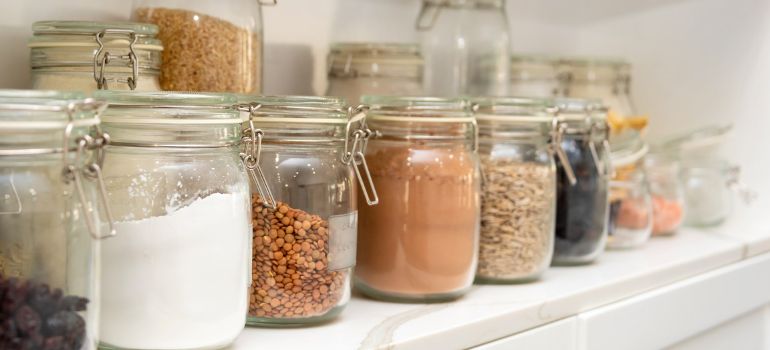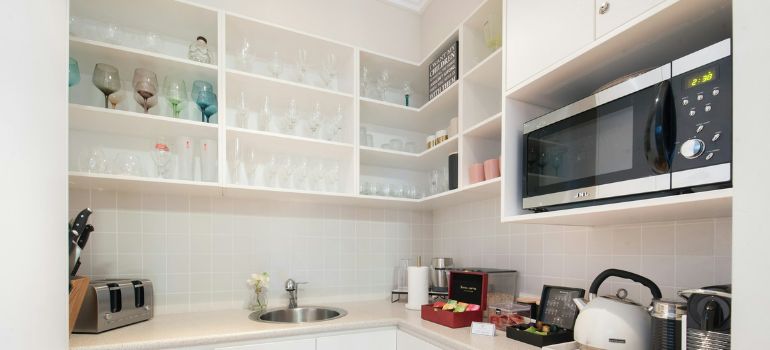In today’s modern kitchens, maximizing storage space has become a top priority. If you’re looking to create a pantry in your kitchen or simply want to make the most of your available space, stacking wall cabinets can be a fantastic solution. This article will guide you through the process of stacking wall cabinets to make a functional and visually appealing pantry.
Understanding the Benefits of Stacking Wall Cabinets
Before diving into the step-by-step guide, let’s explore why stacking wall cabinets is a smart choice:
Increased Storage Capacity
Stacking wall cabinets allows you to utilize vertical space effectively, offering more storage options for your kitchen essentials.
Customization
You can tailor the size and arrangement of stacked cabinets to fit your kitchen’s unique layout and your specific storage needs.
Aesthetic Appeal
A well-designed stacked cabinet arrangement can enhance the visual appeal of your kitchen, making it both stylish and functional.
Cost-Efficiency
Stacking cabinets is often more cost-effective than installing a dedicated pantry, making it a budget-friendly solution.
Step-by-Step Guide to Stacking Wall Cabinets
Now, let’s delve into the process of stacking wall cabinets to create your pantry:
Measure Your Space
Before you start the process of stacking wall cabinets to create your pantry, it’s crucial to measure your available space carefully. Accurate measurements ensure that your stacked cabinets will fit perfectly and provide you with the desired storage capacity. Here’s a step-by-step guide on how to measure your space effectively:
Gather Your Tools
You’ll need a few tools to measure your space accurately:
- Measuring Tape: A flexible measuring tape is essential for precise measurements.
- Pencil: You’ll need a pencil to mark down measurements and notes.
- Notebook or Paper: Use this to record your measurements and sketch your space if necessary.
Measure Height, Width, and Depth
Start by measuring the height, width, and depth of the area where you plan to stack your wall cabinets.
Height:
- Measure from the floor to the ceiling or the desired cabinet height. Ensure that you measure at multiple points along the wall, as ceilings may not be perfectly level.
Width:
- Measure the width of the wall space where you intend to install the cabinets. Measure from one corner to the other, taking note of any obstacles or uneven surfaces.
Depth:
- Measure the depth of the space from the wall to any obstructions, such as appliances or other cabinets. This measurement will help you determine how deep your cabinets can be without interfering with other elements in your kitchen.
Account for Clearances
Consider any clearances required for the cabinet doors to open and close smoothly. Typically, a few inches of clearance on each side of the cabinet doors are necessary to ensure they function correctly.
Take Multiple Measurements
For precision, it’s advisable to take multiple measurements at different points along the wall and at different heights. This helps account for any variations in your wall’s dimensions.
Sketch Your Space
If it helps, create a rough sketch of your kitchen or pantry area. Mark the measurements you’ve taken, including the height, width, and depth. This visual representation will be valuable when planning the placement of your cabinets.
Double-Check Your Measurements
Once you’ve recorded all your measurements, double-check them to ensure accuracy. A small mistake in measurement can lead to ill-fitting cabinets.
Consult Cabinet Specifications
Before purchasing cabinets, consult the specifications provided by the manufacturer. Ensure that the cabinets you select match the dimensions of your available space.
Select Suitable Cabinets
Choose wall cabinets that match your kitchen’s décor and meet your storage requirements. Ensure they are sturdy and of high quality.
Determine Cabinet Placement
Decide how you want to arrange the cabinets. Common options include stacking them directly on top of one another or leaving space between them for open shelving.
Install Wall Brackets
To support the upper cabinets, install wall brackets securely into the wall studs. Make sure they are level and properly spaced.
Hang the First Cabinet
Begin by hanging the bottom cabinet at the desired height, using the wall brackets as support. Make sure it’s level and securely attached.
Stack the Additional Cabinets
Continue stacking the cabinets on top of one another, ensuring each one is level and properly aligned with the others.
Secure the Cabinets Together
To prevent the cabinets from shifting or falling, secure them together using cabinet screws. Follow the manufacturer’s guidelines for this step.
Add Cabinet Hardware
Install cabinet handles or knobs for easy access to your pantry items. Choose hardware that complements your kitchen’s style.
Customize the Interior
Maximize the functionality of your stacked cabinets by adding pull-out shelves, drawer inserts, or other organizers.
Finish with a Countertop
If desired, install a countertop on top of the stacked cabinets to create additional workspace or display space.
Organizing Your Stacked Wall Cabinets

Now that you’ve successfully stacked your wall cabinets to create a pantry, it’s time to organize it efficiently. Here are some tips to help you make the most of your new pantry space:
Categorize Your Items
Begin by categorizing your pantry items. Group similar items together, such as canned goods, spices, baking supplies, and snacks. This will make it easier to locate what you need.
Use Clear Containers
Consider transferring dry goods like rice, pasta, and cereal into clear, airtight containers. This not only keeps your pantry looking neat but also helps you see when you’re running low on supplies.
Install Adjustable Shelving
If you have adjustable shelves in your stacked cabinets, take advantage of this feature. Customize the shelf heights to accommodate different-sized items.
Label Everything
Labeling your containers, shelves, and drawers will save you time and prevent confusion when you’re searching for specific items. Use a label maker or write labels by hand for a personal touch.
Rotate Your Stock
To prevent food waste, practice the “first in, first out” rule. Put newer items behind older ones, ensuring that you use the oldest items first.
Maintaining Your Stacked Cabinet Pantry
To keep your pantry organized and functional in the long run, consider the following maintenance tips:
Regularly Check for Expired Items
Set a routine to check for expired or spoiled items in your pantry. Dispose of anything past its prime to free up space.
Clean and Dust
Occasionally, take the time to clean and dust your stacked cabinets and pantry shelves. A clean pantry is not only more hygienic but also more pleasant to use.
Adjust as Needed
As your storage needs change, don’t hesitate to adjust the organization of your stacked cabinets. What works for you today might need tweaking in the future.
Meal Planning
Use your well-organized pantry to plan your meals more efficiently. Knowing what you have readily available can inspire creative and delicious dishes.
Share with Others
If you have an abundance of non-perishable items, consider sharing with local food banks or community organizations. It’s a great way to give back to the community and keep your pantry in order.
Conclusion
Stacking wall cabinets to create a pantry is an excellent way to optimize your kitchen’s storage capacity while enhancing its overall aesthetics. By following this step-by-step guide, you can achieve a functional and visually appealing pantry that suits your needs and style.
FAQs
Yes, it can work well in small kitchens, as it maximizes vertical space, leaving more floor area available.
While it’s possible, it’s advisable to maintain uniformity in size and style for a cohesive look.
It’s essential to check the manufacturer’s recommendations, but generally, wall cabinets can support a significant amount of weight when properly installed.
Absolutely! Stacking cabinets can be a versatile storage solution in various rooms, including bathrooms and laundry rooms.
You can explore your local home improvement stores or browse online retailers for a wide selection of wall cabinets suitable for stacking.



